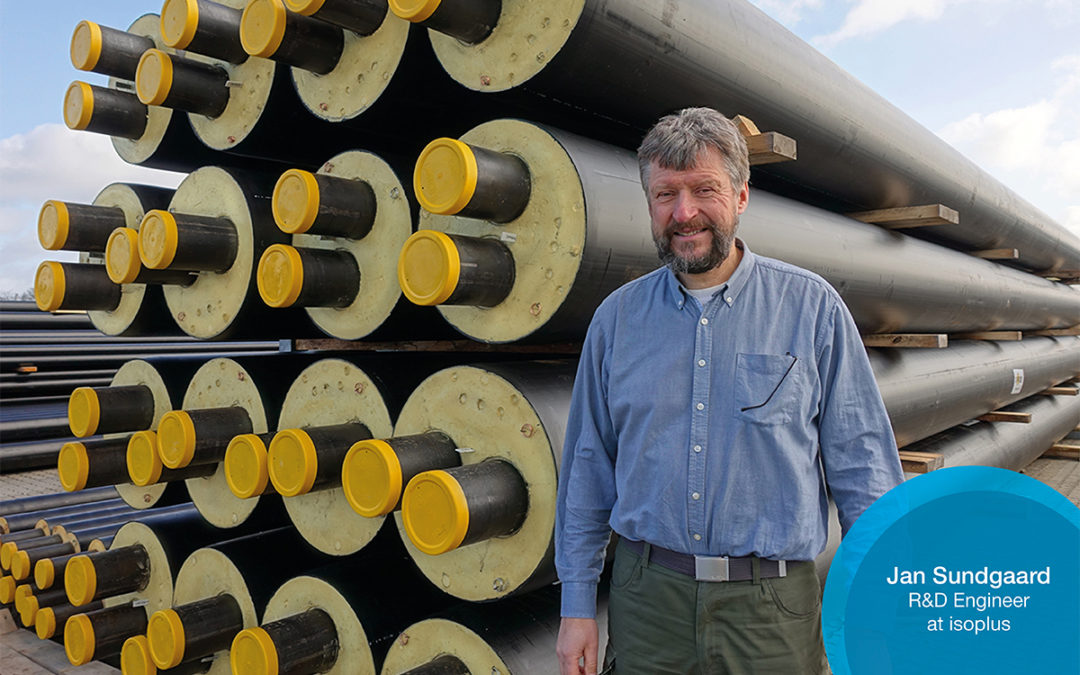Heat loss is a crucial factor when you decide which pipe system to use for your district heating project. We want to ensure that you are well-equipped for making the correct decision because the heat loss greatly impacts the competitive power of district heating compared with individual heating solutions.
With regard to heat loss, the lambda value often has high priority and to many people, the lambda value is actually the only value they look at in relation to heat loss. However, it is a fact that the U-value can give you a much more precise figure for your pipe system’s actual heat loss. Five questions to isoplus’ R&D Engineer, Jan Sundgaard, will introduce you to the jungle of heat loss issues, and you will learn how to ensure the lowest possible heat loss.
What is the difference between lambda value and U-value?
The lambda value is a property of the material and tells you how much energy can be transferred across a certain material. The U-value is a structural property, which tells you how much energy can be transferred across a certain structure. The lower the lambda value, the better insulation properties the material will have. Also, a low U-value indicates that the structure has good insulation properties.
Briefly, the difference between lambda value and U-value is this: the lambda value says something about the material’s properties, and the U-values tells you something about a structure that consists of different materials. In other words, when we speak of a U-value in our industry, it is about the actual pipe, the insulation, the jacket pipe, and the surrounding soil.
How are lambda value and U-value measured?
The lambda value is the amount of energy that can penetrate 1 metre of the material if the temperature difference is 1 degree. However, this method is difficult to use in our situation, because it is about a pipe. Therefore, we heat the pipe to a constant temperature and measure the exact energy required to keep a constant temperature in the pipe. At the same time, we also measure the surface temperature of the jacket pipe, which allows us to see the temperature difference. This means that we are actually first measuring the U-value and then calculate “backwards” to find the lambda value.
The lambda value of a material is usually measured by means of a plate where we measure perpendicularly between two parallel surfaces. In this way, the area of the insulation is more or less equal through the entire insulation. On a pipe, however, we also measure perpendicularly between the inner and outer diameter. The round surfaces of a pipe mean that the area is small at the surface of the carrier pipe, and gradually as you move towards the jacket pipe, the area will increase. Therefore, we measure in a slightly different way when it comes to pipes. Popularly, we speak of “plate lambda” and “pipe lambda”.
What else is looked at during such laboratory tests?
When testing lambda values, we are also frequently conducting cell gas analyses. Here, we look at the type and the amounts of gasses contained in the cells. This may be cyclopentane, which is a gas with really good insulation properties. The cells may also contain CO2, which has medium insulation properties, as well as nitrogen and oxygen – both having weaker insulation properties.
We measure the cells to find the formula for the best lambda value. Both, too much and too little of the different gasses can result in a high lambda value. Therefore, it is really a matter of finding a proper balance. If, for example, there is much cyclopentane there is room for some of the cyclopentane to diffuse out, while there will still be new cyclopentane from the cyclopentane combined in the cell walls. With regard to insulation properties, much cyclopentane is a real benefit, but if there is too much cyclopentane in the cell walls, the cells will heat up and become large – and this will result in a high lambda value.
Which one makes the better statement concerning heat loss – the lambda value or the U-value?
Lambda values are very applicable when it is about comparing the insulation properties of different materials. However, if you wish to assess the heat loss in a pipe system, the U-value is more purposeful. Basically, the lambda value is a material property and, of course, it is important that the insulation has good insulation properties; therefore, the lambda value must be low. But it is even more important that the entire structure ensures a low heat loss – and this is where the U-value matters.
Actually, I don’t quite understand why such importance has been attached to the lambda value because the material properties do not say all there is to be said. I believe that the structure is much more important. Yet the problem is that, if you wish to measure the U-value, you have to measure it in all pipes. We measure the U-value in one pipe, convert it to a lambda value and then use the lambda value to calculate the U-value for all pipes.
The U-value is the value which indicates the real heat loss. Imagine that you use a thick layer of insulation with a very poor lambda value. In this situation the U-value may actually be better than in a pipe with a good lambda value and less insulation. You can also experience a high heat loss although you use an insulation material with lower lambda values, if the structure of the pipe does not leave much room for insulation. Therefore, you should actually rather look at the U-value but, in practice, we always tend to talk about the lambda value.
Which other parameters matter when it comes to ensuring a low heat loss?
At isoplus, we incorporate a diffusion barrier into the jacket pipes. This barrier keeps the lambda values permanently low. The diffusion barrier ensures that CO2 and cyclopentane cannot diffuse from the insulation and make room for nitrogen and oxygen to diffuse instead. The reason for incorporating a diffusion barrier is that plastic is not 100 % diffusion tight. The diffusion barrier shall ensure that the good insulating gasses like CO2 and cyclopentane, which both have a good lambda value, stay in the foam, and gasses from the outside – like oxygen and nitrogen with a poor lambda value – remain on the outside. However, it should be noted that the worth of a diffusion barrier ceases when the jacket pipes are Ø355 or larger due to the wall thickness of the jacket pipe and the insulation thickness of the pipe.
Eventually, you could also see to it that the soil around the pipes is as dry as possible. Dry soil keeps the heat loss lower than wet soil. If a pipe is installed deep in the ground, this will also impact the heat loss. The deeper a pipe is installed, the smaller the heat loss is – but of course this has to be evaluated in each individual case as the installation costs play a major role, too.
At isoplus we believe that the best solutions are made in a close dialogue with our customers. District heating projects require meticulous planning, correct choice of products and installation methods in order to ensure a long lifetime for the piping and the lowest possible heat loss. Contact one of isoplus’ technical consultants on tel. +44 1302 276976 or e-mail sales@isoplus.co.uk to find out how we can help you find the right solution to your project.

